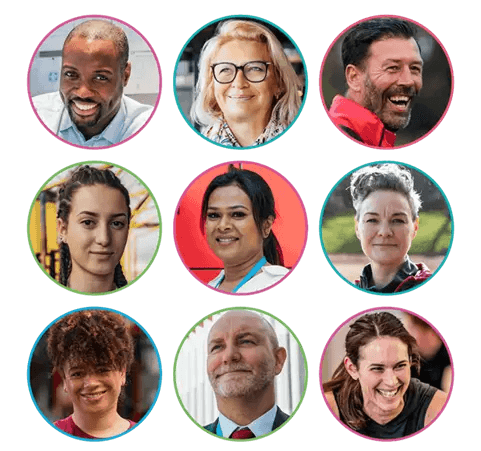Creating role models in sport and physical activity
How our sector workforce can support children and young people to increase their activity levels after Sport England’s report shows many are missing out
On 5 December, Sport England published their latest Active Lives Children and Young People Survey report. The national body’s research into the activity levels of school-age children and their attitudes towards sport and physical activity is world leading, providing detailed insight into the day-to-day of young people in the UK. Since the first report was released for the 2016–2017 academic year, Sport England has been able to build significant insight into how activity levels have changed over the years, including how they have been affected by the pandemic.
In the latest report, the notable datapoints show that children and young people’s activity levels have remained stable over the past year, and their attitudes towards sport and physical activity remain largely unchanged. Over the last academic year, 3.3 million (47.8%) children and young people were active and meeting the Chief Medical Officers’ guidelines by taking part in an average of 60 minutes or more of sport and physical activity per day. Meanwhile, 2.1 million (29.6%) children were “less active”, averaging less than 30 minutes of activity per day.
While stability can be seen as a positive in light of the health challenges of recent years, and it is certainly to be celebrated that 3.3 million children are active, as a sector, we must acknowledge that there is work to be done to improve the activity levels of the remaining majority of young people who do not meet the recommended quantities.
While some of the “less active” group are defined by their age – specifically, children who were aged 4–9 in 2020, showing the stark effect of the pandemic on engagement with activity – there other typically less active demographics that demonstrate persistent inequality.
Girls, those from less affluent families and children from culturally diverse backgrounds are all less likely to be active. This is magnified in children with two or more characteristics of inequality – they are then significantly less likely to be active, with just 40% of these children active for at least 60 minutes a day in comparison with 52% of children with no characteristics of inequality.
Efforts such as increasing the number of leisure facilities in the area and creating new after-school clubs are essential measures improving opportunities for young people to get active, and they generate positive results. This is especially true considering the report’s data highlighting that more children are active outside of school than during school hours. While incorporating movement into the school day is very important, this must be supported by wraparound opportunities for children to enjoy sport and physical activity. Recognising where the majority of children who currently exercise are gaining the recommended levels and maximising the ability for more to benefit in this area will be efficient and effective in improving activity levels across the board.
It is vital, however, to acknowledge that there is a psychological aspect to increasing an individual’s activity levels. Women’s football provides an excellent example of the difference that providing a platform for more high-quality, diverse role models can make to participation in sport and physical activity.
The sport has seen a boom in recent years and gained vast amounts of publicity around the world in comparison to decades prior – resulting in a significant impact on the number of women and girls of all ages taking up football. There are now twice as many registered female football teams in England as there were seven years ago, and in the year after the Lionesses won the UEFA Women’s Euro 2022, almost 1,500 new teams registered.
This rise in popularity and accompanying rise in provisions for sport for women and girls shows a clear link between relatable, professional role models and activity levels.
Although this applies to people of all ages, it is particularly important for children and young people. Not only can having a positive role model in a sport and physical activity space improve their fitness, but having an adult that they look up to can build a child’s confidence, behaviour and overall happiness. These effects are only amplified by the role model being a person that they are in close contact with, such as a coach, rather than a celebrity.
Ensuring a safe and positive experience
For coaches, swimming teachers and other sport and physical activity professionals to be role models for children, proximity is not the only aspect that counts. These individuals must exemplify excellence in their occupations and crucially create a safe and uplifting space for children.
With many high-profile reports of harm in sports environments published in recent years, it is clear that more can be done to support, safeguard and regulate the workforce. In turn, this will allow participants to enjoy safe and high-quality experiences in sport and physical activity.
The foundation for uplifting the workforce in this way is having clearly defined scopes and knowledge requirements for each sector occupation. The sport and physical activity professional standards, which were created by expert employers to define sector job roles, working environments and participant populations, offer clarity on what sector professionals should and are able to do within their role.
These are also supported by professional standards for working with specialist populations, for example, there are professional standards for working with children and working with women and girls. As these documents clearly set out the skills and knowledge required for working with these groups of sport and physical activity participants, they are helping coaches and other sector professionals to increase their expertise in these areas and ensure that not only are they safe and competent in performing their occupation, but also fully equipped to work with participants that may have additional or differing needs.
With training aligned to a specific professional standard, it is becoming increasingly simple for the workforce to find relevant, accurate and up-to-date methods of honing their expertise. A successful example of this has been the courses provided by The Well HQ. Last year, the CIMSPA Education Partner rolled out a pilot course aimed at improving the knowledge of further education college staff around female health, enabling professionals working with young girls to better understand their specific needs and create a better sport and physical activity experience for them.
With these clear standards and high-quality training opportunities setting a benchmark for excellence, many employers and sector professionals are already proactively incorporating them in their work. Employers are increasingly ensuring that their roles are defined in accordance with the relevant professional standard and professionals themselves are able to ensure that any training undertaken is aligned with the necessary competencies it sets out. This improves the knowledgeability of the workforce and allows parents and guardians to place confidence in practitioners to safeguard their children.
Having an understanding of a sport and physical activity professional’s training and capabilities is especially important to parents of children with characteristics of inequality. For example, parents of disabled children need to be certain that their child will be included in activities and physically and psychologically safe. Parents of children from culturally diverse backgrounds that are traditionally less active may not have experience or knowledge in what to expect from practitioners. However, when sector professionals are equipped with qualifications aligned with widely recognisable and clear standards, uncertain parents and guardians are more likely to feel comfortable supporting their child to participate.
The next step in this journey for the sector is exploring workforce registration. As part of the response to the Whyte Review, CIMSPA has been commissioned by Sport England and UK Sport to lead the Workforce Governance and Registration Scheme Project. With the pilot focused on the role of ‘coach’, the project’s aim is to discover whether implementing a workforce registration scheme in the UK sport and physical activity sector is feasible and if so, how this would be managed.
Progress has been positive, as the aim of this potential option is clear – allowing everyone taking part in sport and physical activity to enjoy safe and high-quality experiences, and to be supported in achieving their goals in a positive environment.
Supporting, safeguarding and regulating the workforce will allow and encourage sport and physical activity professionals to be even stronger role models for children. Seeing and interacting with knowledgeable and constructive practitioners – and cementing them as role models – is essential to increasing the activity levels of young people and supporting parents and guardians in encouraging this, too.
The Workforce Governance and Registration Scheme Project
Creating opportunities for participation
While a role model can be anybody, as the Lionesses’ effect has demonstrated, people often choose role models that look like and have a similar background to themselves. When young people have a role model that resonates with their own cultural or personal identity in multiple ways, studies have shown that as well as feeling less stereotyped, they are more motivated and engaged at school.
With continuing challenges with a lack of diversity in the sector workforce, it’s more relevant than ever to encourage a broader range of professionals to start and continue with careers in sport and physical activity.
The best place to start with this is creating more diverse opportunities for children to participate in sport and physical activity – they are the future workforce, after all. Many children with characteristics of inequality feel unable to participate for practical reasons. Additional resources can be costly, and more funding is of course required to enable accessibility through necessary equipment. However, these practical elements must be complemented and supported by the sector workforce carefully planning and proactively ensuring that their practice is inclusive.
This can be done in many ways, for example offering sessions that are accessible to disabled children, or activities just for girls. It’s also important that local employers take notice of the specific needs of their communities – for example, perhaps there are older children that lack confidence in swimming who would benefit from programmes of beginner swimming lessons.
To support practitioners and their employers in boosting the inclusivity of their services, appropriate and high-quality training is essential. Many training providers now offer courses focusing on participants with specific needs, for example those with mental or long-term health conditions and girls experiencing puberty.
To encourage these groups into sports and physical activities, it’s essential that they feel understood and welcome to what can be quite an intimidating environment. Courses centring on these groups provide high-quality insight and practical advice on ways that the sector workforce can support participants in a variety of settings and activities, aiding them to get the most of opportunities for movement.
With a strong connection to sport and physical activity, these supported children are also more likely to want to pursue careers in the sector.


 Alongside lower physical activity levels, an unhealthy diet is also more likely in families from lower socioeconomic backgrounds. By offering a wraparound service, Time4Sport and Time4Wellbeing are able to engage with children and their families to address a wide range of inequality challenges and create a positive, healthy environment for them to grow in.
Alongside lower physical activity levels, an unhealthy diet is also more likely in families from lower socioeconomic backgrounds. By offering a wraparound service, Time4Sport and Time4Wellbeing are able to engage with children and their families to address a wide range of inequality challenges and create a positive, healthy environment for them to grow in. Managed by CIMSPA, the Training Academy for Sport and Physical Activity has been designed in collaboration with employers, education providers and professionals working across the sector to provide easy access to quality-assured CPD and training.
Managed by CIMSPA, the Training Academy for Sport and Physical Activity has been designed in collaboration with employers, education providers and professionals working across the sector to provide easy access to quality-assured CPD and training.
